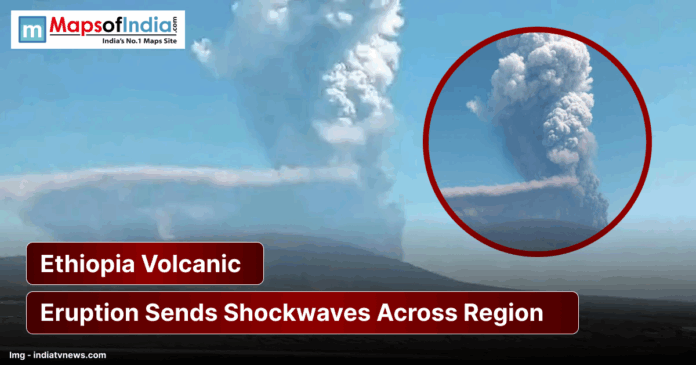A Rare Geological Event Shakes East Africa
Ethiopia had experienced a dramatic and unexpected geological incident when the still Hayli Gubbi volcano in the Afar region suddenly came to life. The volcano resulted in shockwaves around the area with a huge ash cloud being launched approximately 14 kilometres into the sky, and it was considered one of the most notable volcanic activities in African history. Scientists, residents, travellers, and international authorities have been concerned with the eruption as it has affected the whole globe.
First Known Eruption in Millennia
Dormant Since the Holocene
Hayli Gubbi had experienced no recorded eruption of volcanic activity in thousands of years, and this eruption was the first ever to have occurred in the modern era. The fact that this has not only awakened but has also done so abruptly has made the experts analyze what might have caused the eruption after keeping the world quiet for a long period.
A Powerful and Explosive Start
The neighbours heard a loud explosion and an abrupt uprising of the heavy smoke and volcanic ash into the air. In contrast to the slow lava flows that protect the volcanoes commonly associated with volcanoes, this eruption was not only powerful but also explosive, implying the bursting of magma and pressure deep beneath the surface.
Immediate Impact on Local Communities
Villages Covered in Ash
Settlements close to the area of Afdera, as well as others, were covered by grey ash shortly after the eruption. The road system, buildings, trees, and open land were sprayed, which influenced the view and the quality of the air.
Livestock and Livelihoods Under Threat
The Africa Afar area is home to many people who rely on their livestock, and the ash that has settled on grazing fields due to volcanic activities has brought another crisis to the area. The animals can no longer find clean grass or water, which increases the chances of food deficit and loss of the economy. The eruption has contributed to strain in an already weak rural ecosystem, given the fact that people were already living in harsh desert environments.
Tourists Stranded
Afar is also famous for its deserted but beautiful scenery, which attracts sightseers with natural phenomena, including the Danakil Depression. But since ash covered access roads, a number of travellers and tour groupings were caught in limbo, and this caused disruption in one of the most important sectors of the economy of the region.
Ash Travels Across Continents
A Plume Crossing the Red Sea
After the eruption, the volcanic ash cloud spread over the Red Sea to the Arabian Peninsula on the high-altitude winds. It kept floating in regions in Yemen and Oman after moving further east to the Indian subcontinent.
Impact on Air Quality and Visibility
When the cloud ran over South Asian airspace, the north and the western regions of India registered low visibility and hazy weather. The development posed health risks to those who came in contact with fine ash particles, and this is particularly true for young children, elderly people and those who have respiratory problems.
Major Flight Disruptions Across Countries
Ash Risks for Aircraft
Volcanic ash is a great threat to aircraft. The particles may melt in the plane engines, block air systems, impair visibility and harm vital parts. Extreme encounters with ash have resulted in total engine shutdown.
Flight Cancellations and Diversions
Airlines acted on precautionary measures because of the danger of the drifting ash plume. Several flight operations were cancelled or diverted by various carriers, including large Indian airlines that avoided the impacted airspace. The delays and rerouting were experienced by passengers as the authorities issued advisories to conduct safe flight operations.
There are also those airports that modified their operations by giving guidelines on flight paths and insisting on the mandatory check-ups of aircraft when flying along the affected corridor or near it.
Aviation Authorities Respond
The civil aviation agencies in India and other countries that were affected provided guidance to the airlines, advising them to take precautions and recommending that they use alternative flight paths. The incident highlighted the fact that the aviation sector worldwide is extremely fragile to volcanic eruptions at a distance of thousands of kilometres.
Why Did the Eruption Happen?
A Volatile Geological Zone
Hayli Gubbi can be found in the Afar Depression, which is one of the most volcanically active areas on Earth. This region is on a tectonic rift whereby the African and Arabian plates are gradually separating. With time, this movement will make the crust of the earth thin, and the magma will start coming up to the surface.
A Shield Volcano With a Surprise
The lava flows of most of the shield volcanoes are slow and steady. But the violent character of this explosion indicates that the pressure and the gas had been piled up for thousands of years, and then they suddenly burst out.
Limited Historical Data
Due to the remote location and the lack of guarding in the area, there is simply no scientific history of Hayli Gubbi. The volcanic eruption can now be regarded as a unique chance of studying and examining a volcano that has remained silent for over a thousand years. The coming months will see more monitoring in order to establish whether more activity can be expected.
Broader Environmental and Global Concerns
Risks to Local Ecology
Ashfall has the ability to modify the soil quality, pollute water bodies and impact crops and plants. The disappearance of grazing pastures in pastoral societies may lead to a financial crisis in the long run.
Aviation and International Preparedness
This eruption showed that a single volcanic activity in East Africa can cause havoc on the aviation routes in various countries. Contemporary air travel is dependent on synchronized monitoring, communication and response systems to demonstrate the safety of passengers. Hayli Gubbi’s eruption will also impact the future emergency planning and simulation models that will be adopted by aviation authorities across the globe.
Potential Atmospheric Effects
Volcano eruptions may emit considerable amounts of gases such as sulfur dioxide, which may lead to a short-term effect on weather and atmospheric chemistry. Although the long-term effects of this eruption are yet to be examined, scientists will still be monitoring the movement and concentration of the ash and gas in the next few days.
Conclusion
The Hayli Gubbi volcano that suddenly occurred in Ethiopia has made the whole world turn its eyes on one of the regions that do not frequently feature in the international limelight. What started as a geological phenomenon in the distant Afar area quickly turned into a worldwide incident, impacting the local communities, leaving tourists behind, floating in international airspace and interrupting the business of various airlines in several nations.
To scientists, the eruption is a wake-up call to the dynamic and unpredictable nature of the interior Earth. It is a crisis to local families and herders, as it is a crisis endangering livelihoods. And to the international aviation regulators, it is a live test of readiness and organization.
With the investigations and monitoring underway, the world now sits and waits to know whether this eruption is just a one-off thing or it is a new wave of activity in the area.





